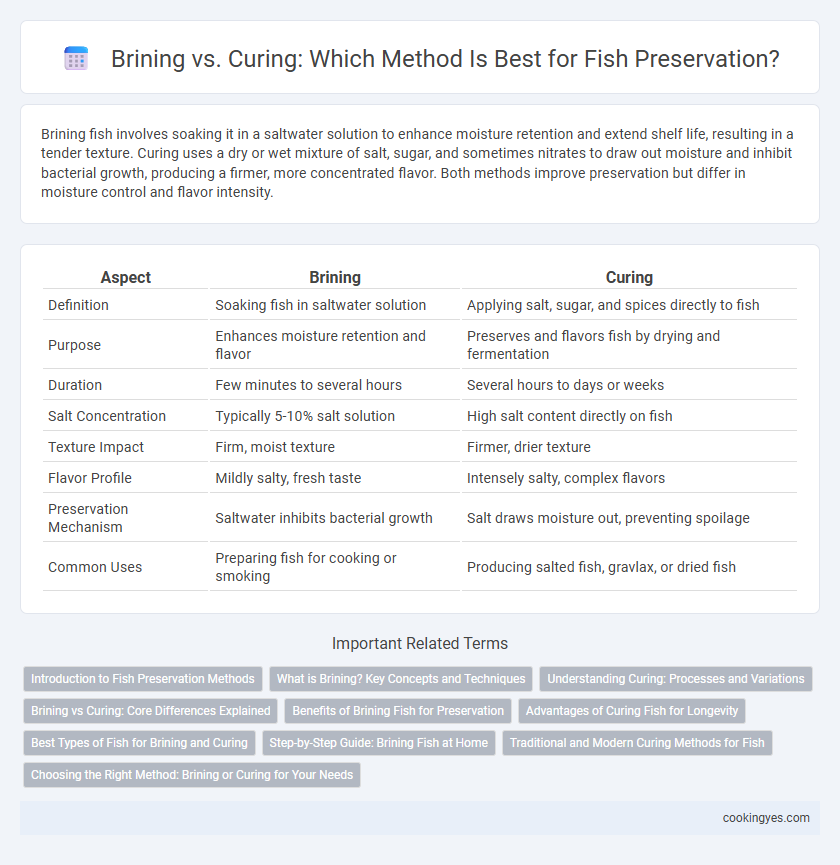Brining fish involves soaking it in a saltwater solution to enhance moisture retention and extend shelf life, resulting in a tender texture. Curing uses a dry or wet mixture of salt, sugar, and sometimes nitrates to draw out moisture and inhibit bacterial growth, producing a firmer, more concentrated flavor. Both methods improve preservation but differ in moisture control and flavor intensity.
Table of Comparison
| Aspect | Brining | Curing |
|---|---|---|
| Definition | Soaking fish in saltwater solution | Applying salt, sugar, and spices directly to fish |
| Purpose | Enhances moisture retention and flavor | Preserves and flavors fish by drying and fermentation |
| Duration | Few minutes to several hours | Several hours to days or weeks |
| Salt Concentration | Typically 5-10% salt solution | High salt content directly on fish |
| Texture Impact | Firm, moist texture | Firmer, drier texture |
| Flavor Profile | Mildly salty, fresh taste | Intensely salty, complex flavors |
| Preservation Mechanism | Saltwater inhibits bacterial growth | Salt draws moisture out, preventing spoilage |
| Common Uses | Preparing fish for cooking or smoking | Producing salted fish, gravlax, or dried fish |
Introduction to Fish Preservation Methods
Brining fish involves soaking it in a saltwater solution to enhance moisture retention and inhibit bacterial growth, making it a preferred method for maintaining texture and flavor. Curing fish, on the other hand, uses dry salt or a mixture of salt and sugar to draw out moisture, effectively preserving the fish by creating an environment hostile to microbial activity. Both techniques have been historically significant in extending the shelf life of fish while developing distinct taste profiles essential in culinary applications.
What is Brining? Key Concepts and Techniques
Brining involves soaking fish in a saltwater solution to enhance flavor, texture, and moisture retention during preservation. Key techniques include controlling salt concentration, temperature, and duration to prevent over-salting while promoting microbial inhibition. This method is effective for both raw and cooked fish, preserving freshness and extending shelf life by maintaining cellular integrity.
Understanding Curing: Processes and Variations
Curing fish involves using salt, sugar, and sometimes nitrates or nitrites to draw out moisture and inhibit bacterial growth, effectively preserving the fish. Variations include dry curing, where salt mixtures are rubbed directly onto the fish, and wet curing or brining, which immerses fish in a saltwater solution for controlled moisture absorption. These processes enhance flavor, texture, and shelf life by creating an environment unfavorable to spoilage microorganisms.
Brining vs Curing: Core Differences Explained
Brining preserves fish by soaking it in a saltwater solution, enhancing moisture retention and flavor while slowing bacterial growth. Curing, often involving dry salt or a mixture with sugar and nitrates, removes moisture from the fish to prevent spoilage and develop a firmer texture. The primary difference lies in brining's use of liquid to maintain juiciness versus curing's moisture extraction for longer shelf life and concentrated taste.
Benefits of Brining Fish for Preservation
Brining fish enhances moisture retention and texture by allowing salt to penetrate the flesh, which inhibits bacterial growth and extends shelf life effectively. This process also improves flavor by evenly distributing seasoning throughout the fish, creating a more palatable and succulent product. Compared to curing, brining offers a quicker preservation method while maintaining the fish's natural tenderness and juiciness.
Advantages of Curing Fish for Longevity
Curing fish enhances longevity by effectively reducing moisture content, which inhibits bacterial growth and spoilage. The process infuses salt and sometimes sugar or nitrates, creating an environment hostile to microbial activity and oxidation. This method not only extends shelf life but also intensifies flavor and improves texture, making cured fish ideal for long-term storage and culinary use.
Best Types of Fish for Brining and Curing
Salmon, cod, and mackerel are ideal for brining due to their firm texture and high-fat content, which enhances moisture retention and flavor absorption. Herring, anchovies, and whitefish are commonly used for curing with salt or sugar, effectively preserving their delicate flesh and intensifying taste. Choosing the right fish type ensures optimal preservation results and elevates the sensory profile in both brining and curing processes.
Step-by-Step Guide: Brining Fish at Home
Brining fish involves soaking fillets or whole fish in a saltwater solution, typically mixing 1 cup of kosher salt with 4 cups of water, for 30 minutes to 2 hours depending on thickness. This process enhances moisture retention, flavor infusion, and shelf life by creating a balanced environment that inhibits bacterial growth. Proper refrigeration during brining at a temperature below 40degF (4degC) ensures safe preservation and optimal texture before cooking or further curing.
Traditional and Modern Curing Methods for Fish
Traditional curing methods for fish involve dry salting or smoking techniques that inhibit bacterial growth by reducing moisture and increasing salt concentration, preserving the fish's texture and flavor naturally. Modern curing methods incorporate controlled brining with precise salt concentrations and often combine refrigeration or vacuum sealing to enhance preservation while maintaining fish quality. Both approaches focus on preventing spoilage, but modern techniques offer greater consistency, safety, and efficiency in extending the shelf life of fish products.
Choosing the Right Method: Brining or Curing for Your Needs
Brining involves soaking fish in a saltwater solution to enhance moisture retention and improve texture, making it ideal for delicate species like salmon. Curing, which uses dry salt mixtures often combined with sugar and nitrates, is better suited for longer preservation and intense flavor development, as seen in traditional gravlax or smoked fish preparations. Selecting between brining and curing depends on factors such as desired taste, preservation duration, and the specific type of fish being treated.
Brining vs Curing for fish preservation Infographic

 cookingyes.com
cookingyes.com